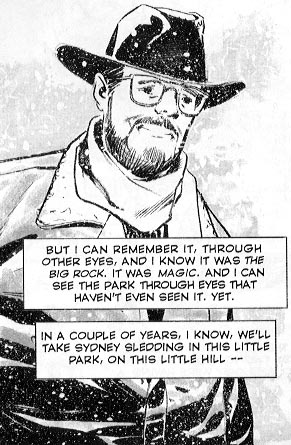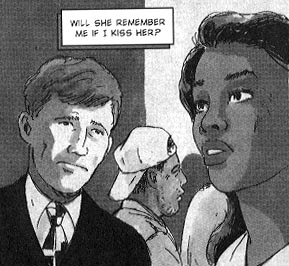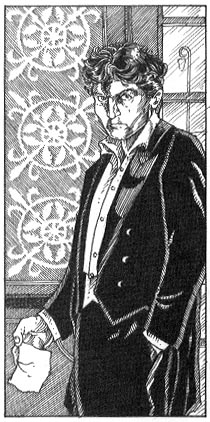 Edited by Joe Pruett
Edited by Joe Pruett
96 pages, black and white
Published by Image Comics
I really miss getting regular, high-quality comic anthologies. There have been a handful of good ones over the years, like Dark Horse Presents, Oni Double Feature, and Pulp. One that I used to pick up on an irregular basis was Negative Burn from Caliber Press; with it being a regular series, so much would depend on which creators were in a particular issue. Now, Image and Desperado Publishing have brought it back as a series of graphic novels, and based on this first taste, I think that good times are ahead.
 Negative Burn: Winter 2005 was clearly intended to hit stores a little earlier than it actually did, and that’s especially clear with its opening piece from Kurt Busiek and Steve Lieber about childhood memories of winter. Busiek tells it in a laid back, conversational manner; you can almost hear his voice as if he’s telling it to you personally. Coupled with Lieber’s realistic art, the story comes to life as you’re looking at the glee of the young Busiek’s face as his saucer sled zooms down off of a snow-covered boulder, or looking wistful as he imagines eventually taking his daughter Sydney sledding herself. It’s the perfect start to the anthology, setting a high mark for the rest of the book to follow.
Negative Burn: Winter 2005 was clearly intended to hit stores a little earlier than it actually did, and that’s especially clear with its opening piece from Kurt Busiek and Steve Lieber about childhood memories of winter. Busiek tells it in a laid back, conversational manner; you can almost hear his voice as if he’s telling it to you personally. Coupled with Lieber’s realistic art, the story comes to life as you’re looking at the glee of the young Busiek’s face as his saucer sled zooms down off of a snow-covered boulder, or looking wistful as he imagines eventually taking his daughter Sydney sledding herself. It’s the perfect start to the anthology, setting a high mark for the rest of the book to follow.
Negative Burn has a nice mix of both completely original stories and ones connected to ongoing series. What’s important with the latter category is that the creators have recognized that for many readers, this will be their first exposure to that particular group of characters or stories and to treat the audience appropriately. Erik Larsen’s “The Wish”, for example, is a hysterically fun story with little more than a conversation between a kid and her megalomaniacal friend over what one would do with a single wish. All the important back-story is mentioned in the very first panel, with Larsen cleverly jumping into the heart of the matter, with the difference between children and adults on what one’s single wish would be. If one wasn’t told that these were characters from Savage Dragon you’d never know; ultimately all that really matters for the reader is all included here, and as a result he’s able to make this absolutely charming.
Ron Marz and Luke Ross, rather than plunge the reader into the middle of their Samurai: Heaven and Earth mini-series, offer up a prequel here. It’s a nice little story, although it’s interesting contrasting it with Larsen’s contribution. At the end of “The Wish” I found myself wanting to read more Savage Dragon because it was genuinely funny and I wanted to see just what these characters would do next. With Marz and Ross’s story, while it’s talented, it almost felt a little too blatant on how it ended, unable to really stand on its own as anything but a direct lead-in to their series over at Dark Horse, and giving you as a reader a sense of incompleteness.
 For me, it’s some of the stand-alone stories that really stand out. One of the stories that struck me the most was Darko Macan and Wayne Vansant’s “Impressions” which asks the question on if we’ll really leave any sort of mark on the world. It’s a short but powerful story, with a real sense of grace about it and carefully avoiding trying to give any sort of “yes, this is the answer to everything” ending that so many stories like this attempt. At perhaps the opposite end of the spectrum is Fabian Nicieza and Dalabor Talajic’s “The Drop”, a glimpse into a world where a comet gave a handful of people super-powers, and a petty criminal’s attempt to get by. It’s a fun, fast story, and it’s a reminder that in Negative Burn there’s room for both “Impressions” and “The Drop”; very different from each other, but both high in quality.
For me, it’s some of the stand-alone stories that really stand out. One of the stories that struck me the most was Darko Macan and Wayne Vansant’s “Impressions” which asks the question on if we’ll really leave any sort of mark on the world. It’s a short but powerful story, with a real sense of grace about it and carefully avoiding trying to give any sort of “yes, this is the answer to everything” ending that so many stories like this attempt. At perhaps the opposite end of the spectrum is Fabian Nicieza and Dalabor Talajic’s “The Drop”, a glimpse into a world where a comet gave a handful of people super-powers, and a petty criminal’s attempt to get by. It’s a fun, fast story, and it’s a reminder that in Negative Burn there’s room for both “Impressions” and “The Drop”; very different from each other, but both high in quality.
Eric Stephenson and Jamie McKelvie’s “A Different Kind of Tension” is the sort of story where you feel like you’ve actually been there before; between dialogue and art, there’s such a level of realism about it that it’s almost painful to read all the way to its conclusion. (Which, ultimately, is the point.) Alternately, “Quorzar 13, Honorable Conqueror of the Galaxy” is a story where you probably wish you’d been there as a child. Zander Cannon’s The Replacement God always had just the right level of playfulness and fun, and his work with Kevin Cannon and Shad Petosky is quite possibly the best snowball fight story ever told. There’s such a wonderful level of whimsy about it that you can’t help but grin from start to finish; it’s great to see an anthology that has room for a piece of pure fun like this.
 I was happy to see that Negative Burn isn’t afraid to still have the occasional gag strip in its pages. Brian Bolland’s “Mr. Mamoulian” was a mainstay of the original anthology, and seeing its hapless protagonist back in a story about being rebranded by a marketing company was worth a chuckle. Even better, though, was Evan Dorkin’s “Milk and Cheese: Break Out!” with a disgusting journey into the world of acne. Every time I’ve begun to despair of ever seeing another violently funny “Milk and Cheese” strip, Dorkin proves me wrong, and this one’s just as entertaining as ever, taking everything to its ludicrous and revolting extreme.
I was happy to see that Negative Burn isn’t afraid to still have the occasional gag strip in its pages. Brian Bolland’s “Mr. Mamoulian” was a mainstay of the original anthology, and seeing its hapless protagonist back in a story about being rebranded by a marketing company was worth a chuckle. Even better, though, was Evan Dorkin’s “Milk and Cheese: Break Out!” with a disgusting journey into the world of acne. Every time I’ve begun to despair of ever seeing another violently funny “Milk and Cheese” strip, Dorkin proves me wrong, and this one’s just as entertaining as ever, taking everything to its ludicrous and revolting extreme.
In addition to regular stories, Negative Burn isn’t afraid to entertain other entries into its pages. A six-page sketchbook section from Vince Locke is a nice break in the action, providing a glimpse into preliminary drawings as well as finished pieces from a real master of gore. James Owen’s “Obscuro”, the first of a six-part story (and the only serialized entry in Negative Burn: Winter 2005) is a nice cross between an illustrated prose piece and sequential art; there’s an old, Victorian feel to it, and it’s easy to see why editor Joe Pruett decided to go with it as the first serialized piece for the new series.
Image has published a lot of good anthologies lately, like the Flight books as well as Four Letter Worlds, and Negative Burn: Winter 2005 definitely falls into that category. Hopefully this is the first of lots of goodness to come. A handsome graphic novel for just $9.95, I like the idea of having plenty of volumes next to it on my bookshelf in the years to come. Ultimately, I don’t mind that Negative Burn: Winter 2005 might have been more appropriately been dated “Summer 2005” because if the extra time meant we got as many good stories as we did, then I can’t complain one bit.
Purchase Links: Amazon.com
